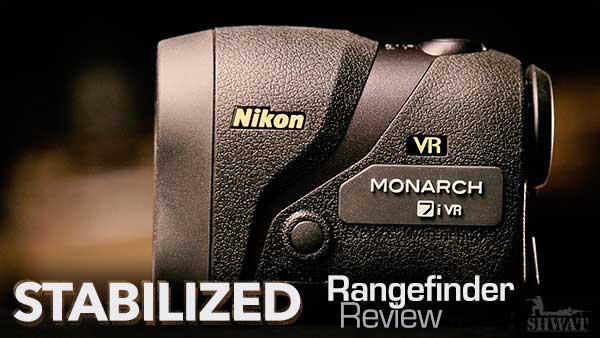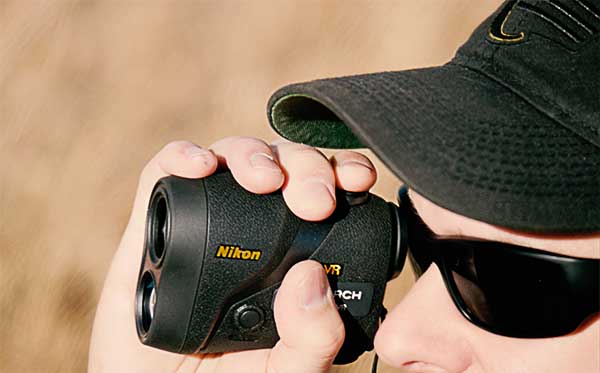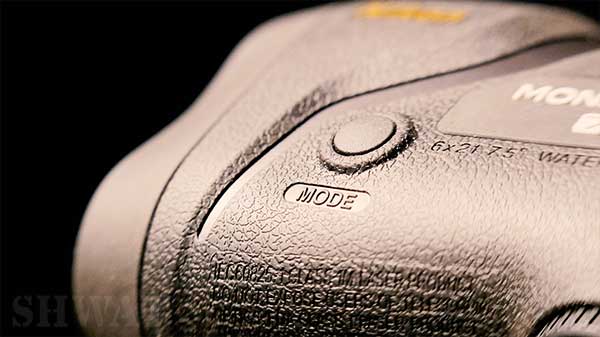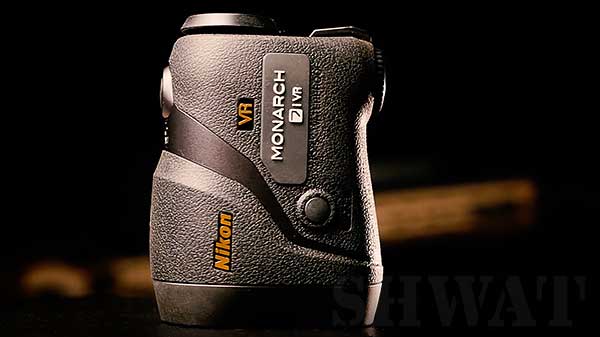
The Nikon Monarch 7i VR has been traveling with me for a few months now. It’s gotten dirty, crossed state lines, gone hunting… You get the idea. It is unlike any other rangefinder I know of, but very much like the camera and video gear I’ve used for years. We’ll jump into the details and a video below, but here’s what really makes this my absolute favorite rangefinder at the moment: Image stabilization!
The “VR” in “Monarch 7i VR” stands for “Vibration Reduction.” But that phrase doesn’t really capture the magic that this Nikon rangefinder performs. Let’s put this in context. Ever use a laser rangefinder in the cold? Cold can be cause for some less than steady hands, right? Buck fever has been known to cause plenty of missed shots from shaky hands. Strong winds can make it tough to keep your rangefinder on target. Ultimately, the further your target distance, the more you notice the movement of your rangefinder in your hands. Distance makes it harder to hold steady on your target which is why some rangefinders come with a tripod mount. The Nikon 7i VR lacks that mount, instead giving us a tripod free image stabilization that is simply impressive.
Before I got this rangefinder I understood how it worked. I have stabilized lenses and cameras that compensate for shaky hands. But the grin was just as genuine the first time I ranged with the 7i VR. I took it on a hunt and handed it to a buddy. Peering through the 6x magnified optic, he confidently called out the range to our target. “That’s pretty nice to use, isn’t it?” I commented. “It’s really great,” his reply. I told him to just look through it as an optic without activating the rangefinder for a moment, then to press the button. “Wow, I just thought I was that stable today,” he laughed. And therein lies the magic.
Your hands shake, the rangefinder shakes with them, but this waterproof Nikon stabilizes the optics so you get on your target and stay on it. The truth is, that’s impossible to demonstrate in a written review. It takes a video, but that’s not easy either. I’ve watched some reviewers mount the 7i VR and tap on it to show that it works. It’s not a bad idea, but it’s not how we use the rangefinder.

It’s designed to be hand held and used like other competing rangefinders. We hold them against glasses or our brow, laze the target and get our range back. For our video, I decided to go completely hand held, holding the range finder in front of a video camera lens. Filmed in very windy conditions and without any additional support (no point of contact like glasses or brow) the results are abnormally shaky. So this isn’t perfect either, but I think it is closer to real life use.
Importantly, not only is your image stabilized, but the laser is stabilized and synchronized with the optics. The combination is what gives accurate results.
In the video, you’ll see I’m wearing sunglasses. The eye relief on the Nikon 7i VR is perfect for that. Without glasses, I’m either free handing like I did to film through the rangefinder or I rest my index finger over the top of the eyepiece and against my brow. The latter is the better method. That eyepiece is an adjustable diopter, giving a sharp image to users with varying degrees of vision acuity.

The Nikon 7i VR does other tricks besides stabilization. What Nikon calls “Tru-Target” tech gives you two modes to range a target. “First Target” mode does what you’d expect – the first target it sees it measures. The distance mode delivers the distance of the farthest target the rangefinder sees. At least that’s the theory. It works pretty well in my tests. Occasionally it will give me a closer target when I’m measuring through brush or trees. Everything has its limitations, and it may be that I’m exceeding the design specs. When I’ve been able to create the issue, I’m usually able to resolve it simply by re-ranging, moving the crosshair slightly and getting a reliable result.
The 7i VR from Nikon also differentiates between horizontal distance and straight distance. That’s a subject for another article, but the short version is this: When shooting down (or up for that matter), the range numbers you use to shoot accurately change. This rangefinder accounts for that up to +/- 89 degrees. Doubtful that any of us will ever need to shoot at that angle, but it’s nice to know it’s capable.

Compared to a couple of other rangefinders I own, I like the exaggerated bell design. The ridge near the front of the 7i VR provides a solid grip. Most of the rest of the outside is rubberized so you don’t have much of an excuse for dropping it regardless the environmental conditions. Nikon provides a nice little case and lanyard as well, so there’s no reason to ever lose it in the field.
The Monarch 7i VR has become my primary rangefinder (out of four). Compact and weighing 7.1 ounces plus whatever a little CR2 lithium battery weighs, it’s easy to take shooting and hunting wherever I go. It’s most of $400 everywhere I looked, about $100 more than some similar models from competitors. But in reality, there are no competitors now if you want a stabilized hand held rangefinder. Definitely worth the extra $100 in my book. What do you think? Add your thoughts or questions in the comments below.


I bought Monarch 7i. VR last month paid $389.99 plus the State extortion tax. That put me at about $407 out the door. Just for S and G’s I took a turkey hunting and ranging was fantastic with previous known distances. A couple of days later I was up in the Paso Robles area of California pig hunting and had a measured shot at about 21 1/2° uphill I used the data from the range finder and my app and they where within 7 yards the Nikon ranged the shot at 279 yards and a Luepold ranger read the distance at 324. Shot placement was perfect using the Nikon distance value. Other pigs where also taken in out group over the next couple of days in early April on the hunt. The Nikon has also performed excellent shooting coyotes lately in desert. I just wish it could read the wind also and eliminate the need for one more tool. BTW the rifle is a GA Precision 6.5 Creedmore With the Templer action with Leopold mark 4 glass. Currently I’m using the Knights armament bullet flight app. The view with the Nikon is simply fantastic with crystal clear glass that extends well into dusk and is even usable under a fuller moon in the desert. This rangefinder virtually illuminates all shaking and vibration you would normally experience. This simply is one of my newest favorite pieces of equipment to hunt with I can’t wait for deer and elk season to see how it performs in the cold Idaho mountains. Maybe even get a lottery Sheep or Moose this year. We can hope can’t we?
Sounds exciting! Yes we can hope, and we’re hoping with you! By all means, keep us posted. Maybe you could share your stories here!